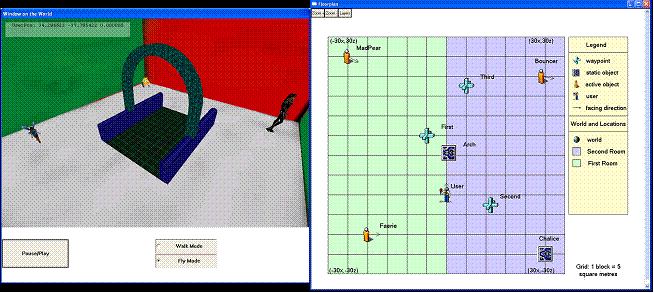
| Visual Strategies for Designing and Implementing Interactions in Virtual Worlds |
||
| Enabing Ordinary Users to Create Interactions in Virtual Environments |
||
Several problems prevent 3D worlds, such as virtual reality (VR) from being widely used outside academic institutions and computer game development. Two of these problems are the long and costly development process to create a virtual environment (VE) and the fact that development is largely in the hands of programmers In this doctoral research project Cara Winterbottom is focussing on user interactions with objects and the environment; and object interactions with each other and the environment. She is exploring ways to help designers visualise and implement the interactions in a 3D world. The process will be to reduce the complexity of this task by understanding the practices of expert designers and incorporating these into a tool that will guide new designers. In order to understand how expert designers work to reduce task complexity, one must understand how they think about the issue. In other words, one must understand how the designer's knowledge is learned and used. Constructivism is a theory of knowledge that directly examines such issues. According to constructivism, knowledge is constructed by the individual through interactions with the environment and social interactions. This theory has informed the research and design of strategies for interaction design. The Underlying IssuesOne of the main reasons for the difficulty of conceptualisation and creation of interactions within a VE is because of the nature of interactive 3D worlds in general and VR in particular. A linear script of the interactions that will occur in an environment is not possible. There are multiple possibilities and combinations, each of which must be examined when a world is designed. Even for experienced designers, conceptualising all of the possible interactions that might occur is a difficult task. Large and complicated design documents are produced, which detail the interactions and how they fit together. These usually contain various visual representations, such as flowcharts, storyboards, use cases and floor plans, which help to organise the flow and sequence of interactions. Designers have various techniques and ways of thinking that they can apply to the problem. For those who are inexperienced in design, creating interactions and visualising them in a complete and consistent sequence is even more daunting. Not only must they accomplish a task that is difficult even for experts, but they lack the practical experience and knowledge that would allow them to handle the complexity. In addition, complex programming and scripting have traditionally been the only ways to specify interactions. This means that those who have the skills and background to create the most interesting and engaging content (i.e., they are experts in their own fields, such as art, graphic design, architecture, etc) are unable to do so, unless they form part of a large multidisciplinary team.
A 3-D view with a corresponding floorplan. A floorplan helps to disentangle spatial errors and can be used to graphically place or define objects, waypoints for movement, facing of objects, locations within the VE, etc |
||
Co-Researchers
James Gain
Students
Cara Winterbottom
